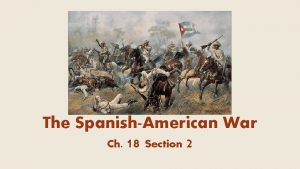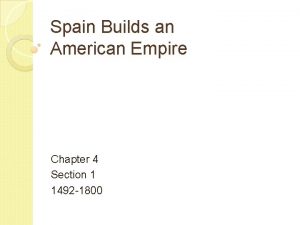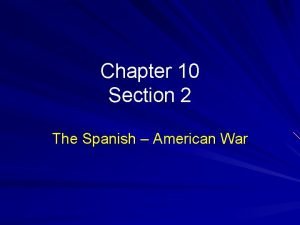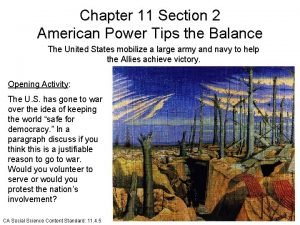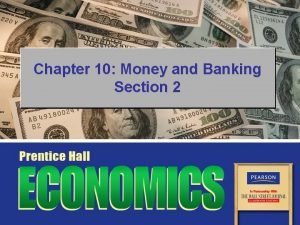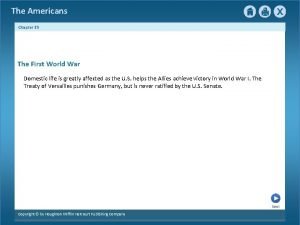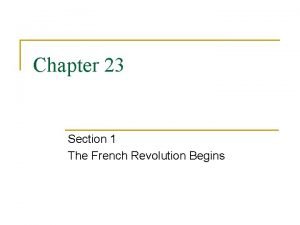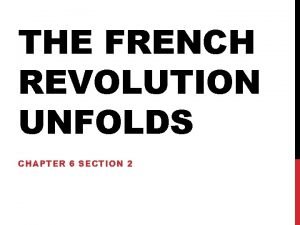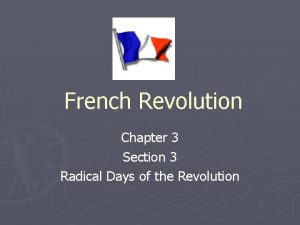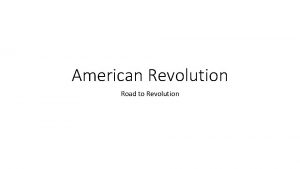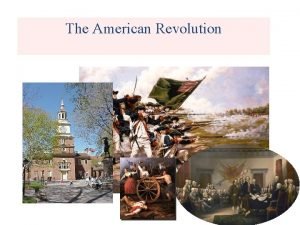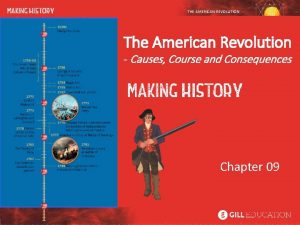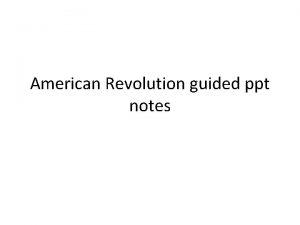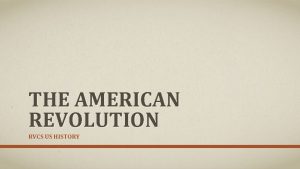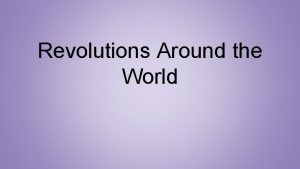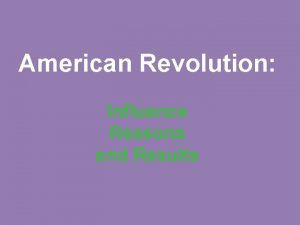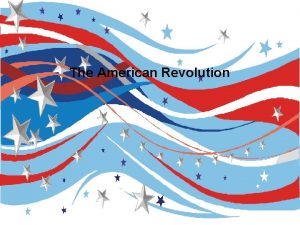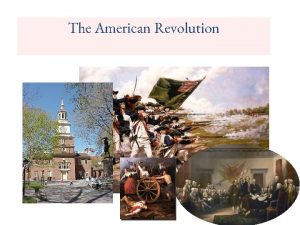CHAPTER 4 The American Revolution SECTION 1 Revolution














- Slides: 14

CHAPTER 4: “The American Revolution”

SECTION 1: Revolution Begins” “The

• First Continental Congress: -In response to the Boston Harbor closing, as well as many other “abuses” caused by Great Britain, the colonists agreed to send representatives from each colony (except for Georgia). -The representatives met in October 1774 at Carpenters’ Hall in Philadelphia, PA. -The meeting was known as the First Continental Congress: was a gathering of colonial leaders who were deeply troubled about the relationship between Great Britain and its colonies in America.

• First Continental Congress: -Patrick Henry and others, felt that violence was unavoidable. Delegates from Pennsylvania and New York had strict orders to seek peace. -Compromise: Colonists encouraged to continue to boycott British goods, but told colonial militia to prepare for war. -Drafted the Declaration of Rights: list of 10 resolutions to be presented to King George III. - Right to “life, liberty, and property”.

• First Continental Congress: -First Continental Congress DID NOT seek to separate from Great Britain. -Goal: to state the colonists’ concerns and ask the King to correct the problems. -Patrick Henry: -went back to Virginia to encourage support for the Patriot cause. “Give me liberty or give me death”. -Patriots: colonists who chose to fight for independence from Great Britain.

• “Shot Heard ‘round the World”: -Thomas Gage (governor of Massachusetts) learned about a stockpile of weapons stored in Concord. -April 1775 he secretly seized the supplies. -Spies informed the Patriots. -Paul Revere (member of Sons of Liberty) created a plan: -Robert Newman was to climb the steeple of the Old North Church and watch for British soldiers.

• “Shot Heard ‘round the World”: -If British advanced across land, Newman would display one lantern from steeple. If British rowed across the Charles River, Newman would display two lanterns. -Paul Revere and William Dawes saw two lanterns, they set off on horseback. -Took two different routes out of Boston to sound the alert. -Towns responded to their alert by using drums and ringing church bells to call out local militia.

• “Shot Heard ‘round the World”: -Minutemen: local militia; who got their name because they were ready to fight at a minute’s notice. Battle at Lexington: -April 19, 1775 British troops arrived. 70 armed minutemen waited. -Patriot captain John Parker ordered minutemen, “Don’t fire unless fired upon”. -Shot fired (no one knows who fired first shot). The shot was known as “Shot heard ‘round the world”. -Minutemen: 8 killed and 10 badly wounded. -British: 1 solider wounded. British marched to Concord.

• “Shot Heard ‘round the World”: Battle at Concord: -Concord was warned about British troops, so they hid/concealed their weapons. -British frustrated because they could not locate stockpile of weapons, burned a few buildings. -Minutemen reacted by fighting. Skilled colonial marksmen found it easy to shoot British with their red coats. British were called Redcoats because of the color of their jackets. -British forced to retreat to Boston with many casualities.

• Second Continental Congress: -King George III refused to address concerns in Declaration of Rights. -May 1775 delegates from 12 colonies met again in Philadelphia. -Second Continental Congress: The second group of delegates from the colonies. -Delegates debated between war and peace. -Compromise: Asked the colonies to set up conventions to write new state constitutions. Authorized Massachusetts militia to become the Continental Army.

• Second Continental Congress: -Continental Army: Force would soon include soldiers from all colonies and would carry out the fight against the British. -George Washington: Virginian who commanded the army. -Congress created Olive Branch Petition, which was final attempt to restore harmony. King George III refused to read it and further punished colonies.

• Early Battles: -Boston was key city in early days of war. Both sides fought to control it. Bunker Hill: -Colonists needed supplies in Boson, so they sent Benedict Arnold and 400 men to New York State. -Objective: attack Fort Ticonderoga. Arnold captured the fort and its large supply of weapons. -June 17 th in Boston, British awoke to colonial forces that dug in at Breed’s Hill (a point overlooking north Boston). Redcoats have to cross Boston Harbor and fight uphill.

• Early Battles: -2, 400 British troops advanced while 1, 600 militia waited. Militia low on gun powder, so they wore ordered not to fire, “until you see the whites of their eyes”. -As British advanced uphill, they were cut down and retreated twice. On third advance, militia ran out of ammunition and had to retreat. -This battle is known as the Battle of Bunker Hill, although it was actually launched from Breed’s Hill. -The battle proved that the Patriots could take on Redcoats. It was a tragic victory for British because they sacrificed about double the number of patriot soldiers to win.

• Early Battles: Dorchester Heights: -Washington arrived in Boston with troops, but needed heavy artillery. -Henry Knox assigned to transport cannons from Fort Ticonderoga to Boston. He brought cannons 300 miles of rough terrain in the middle of the winter. -March 4, 1776, Washington advanced on Dorchester Heights. He positioned himself at Nook’s Hill (overlooking British position). British retreated to Canada. -Patriots know control Boston.
 Chapter 6 section 4 the american revolution
Chapter 6 section 4 the american revolution Chapter 6 section 4
Chapter 6 section 4 How could the french revolution been avoided
How could the french revolution been avoided Chapter 18 section 2 the spanish american war
Chapter 18 section 2 the spanish american war Chapter 8 section 1 latin american peoples win independence
Chapter 8 section 1 latin american peoples win independence Chapter 4 section 1 spain builds an american empire
Chapter 4 section 1 spain builds an american empire The spanish american war chapter 10 section 2
The spanish american war chapter 10 section 2 American power tips the balance
American power tips the balance Chapter 10 section 2 the history of american banking
Chapter 10 section 2 the history of american banking Chapter 19 section 4 wilson fights for peace
Chapter 19 section 4 wilson fights for peace Chapter 6 the scientific revolution
Chapter 6 the scientific revolution The french revolution begins chapter 7 section 1
The french revolution begins chapter 7 section 1 Chapter 23 section 1 the french revolution begins worksheet
Chapter 23 section 1 the french revolution begins worksheet Chapter 6 section 2 the french revolution unfolds
Chapter 6 section 2 the french revolution unfolds Chapter 18 section 3 radical days of the revolution
Chapter 18 section 3 radical days of the revolution



